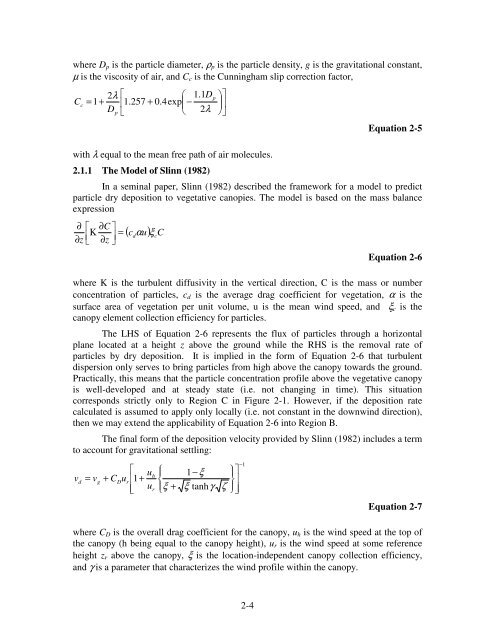FIELD TESTING AND EVALUATION OF DUST DEPOSITION AND ...
FIELD TESTING AND EVALUATION OF DUST DEPOSITION AND ...
FIELD TESTING AND EVALUATION OF DUST DEPOSITION AND ...
Create successful ePaper yourself
Turn your PDF publications into a flip-book with our unique Google optimized e-Paper software.
where D p is the particle diameter, ρ p is the particle density, g is the gravitational constant,<br />
µ is the viscosity of air, and C c is the Cunningham slip correction factor,<br />
C<br />
c<br />
2λ<br />
<br />
1.1D<br />
<br />
= + + −<br />
p<br />
1 1.257 0.4exp <br />
D <br />
2 λ<br />
p<br />
<br />
Equation 2-5<br />
with λ equal to the mean free path of air molecules.<br />
2.1.1 The Model of Slinn (1982)<br />
In a seminal paper, Slinn (1982) described the framework for a model to predict<br />
particle dry deposition to vegetative canopies. The model is based on the mass balance<br />
expression<br />
∂ ∂C<br />
<br />
=<br />
z <br />
Κ<br />
∂ ∂z<br />
<br />
<br />
( c αu) C<br />
d<br />
ξ c<br />
Equation 2-6<br />
where K is the turbulent diffusivity in the vertical direction, C is the mass or number<br />
concentration of particles, c d is the average drag coefficient for vegetation, α is the<br />
surface area of vegetation per unit volume, u is the mean wind speed, and ξ c is the<br />
canopy element collection efficiency for particles.<br />
The LHS of Equation 2-6 represents the flux of particles through a horizontal<br />
plane located at a height z above the ground while the RHS is the removal rate of<br />
particles by dry deposition. It is implied in the form of Equation 2-6 that turbulent<br />
dispersion only serves to bring particles from high above the canopy towards the ground.<br />
Practically, this means that the particle concentration profile above the vegetative canopy<br />
is well-developed and at steady state (i.e. not changing in time). This situation<br />
corresponds strictly only to Region C in Figure 2-1. However, if the deposition rate<br />
calculated is assumed to apply only locally (i.e. not constant in the downwind direction),<br />
then we may extend the applicability of Equation 2-6 into Region B.<br />
The final form of the deposition velocity provided by Slinn (1982) includes a term<br />
to account for gravitational settling:<br />
v<br />
d<br />
= v<br />
g<br />
+ C<br />
D<br />
uh<br />
ur<br />
1<br />
+<br />
<br />
ur<br />
<br />
<br />
ξ +<br />
1−ξ<br />
ξ tanhγ<br />
<br />
<br />
<br />
ζ <br />
−1<br />
Equation 2-7<br />
where C D is the overall drag coefficient for the canopy, u h is the wind speed at the top of<br />
the canopy (h being equal to the canopy height), u r is the wind speed at some reference<br />
height z r above the canopy, ξ is the location-independent canopy collection efficiency,<br />
and γ is a parameter that characterizes the wind profile within the canopy.<br />
2-4
















